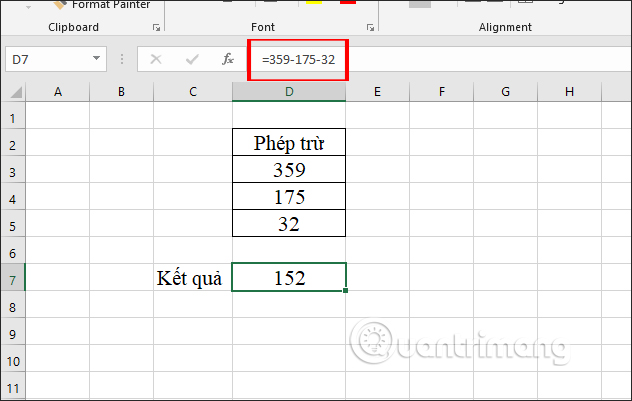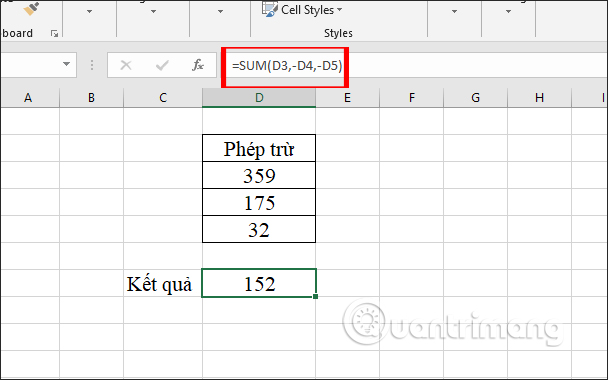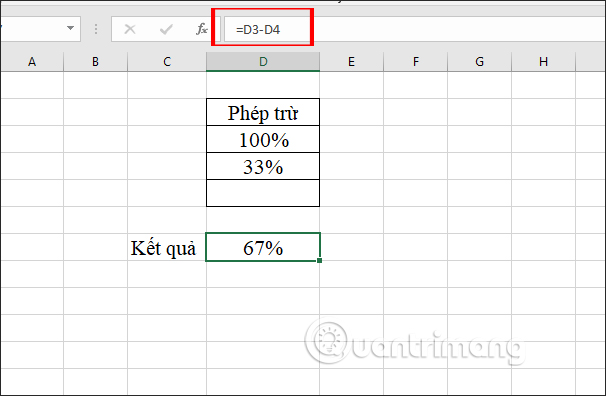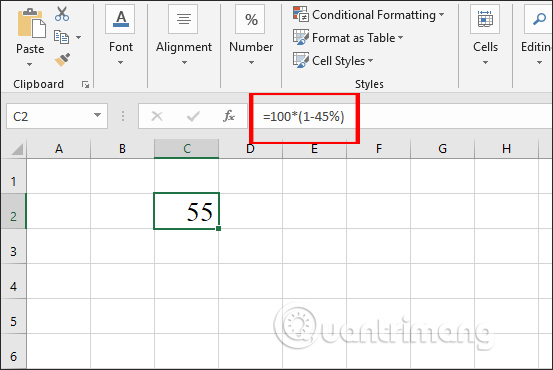How to use subtraction in Excel
Excel functions or Excel formulas are all basic tools for users to process data in data tables. Subtraction in Excel has no calculation function to implement, but we will use the '-' operator. Subtraction is used for many different cases, except for many cells in the data table, except for the percentage in Excel to apply to each different calculation. The following article will guide you how to use subtraction in Excel as well as some examples of subtraction.
- The easiest way to calculate the percentage (%)
- How to use the kernel function (PRODUCT function) in Excel
- 3 ways to calculate totals in Excel
- How to automatically calculate and copy formulas in Excel
Instructions for performing subtraction in Excel
1. Subtract many cells in Excel
To perform calculations except for many cells in Excel, we will use the '-' operator or use the SUM function in Excel.
Example 1: Use a minus sign
With the use of the minus sign, we only need to enter the = sign and then enter the subtraction for the numbers to be calculated in the data table and press Enter to get the result.

Example 2: Use the SUM function
The SUM function for calculating subtraction in Excel will have 2 ways to do it. We will add - to convert arguments to negative values , thus subtracting. Follow the way through the example table below.

Or we use the formula = D3-SUM (D4: D5) and also give the same result. The simple interpretation of this calculation is D3- (D4 + D5).

2. Subtract percentages from Excel
The subtraction of% in Excel is still done as usual when calculating subtraction.

Or if you want to perform subtraction from a number to calculate the percentage value, press the formula = Number * (1-x%). You follow how to follow the example below.

3. Subtract dates from Excel
The simple way to do it is to use the '-' sign in the calculation except the date. Or we use the DATE function in Excel to calculate the date value.

Above is how to use subtractions in Excel and some examples using subtraction. Subtraction is very simple, just apply the '-' operator.
I wish you all success!
You should read it
- How to display 0 in front of a number in Excel
- How to add computers to Excel
- How to fix the SUM function doesn't add up in Excel
- Tips for adding in Excel you need to know
- Get started with Excel for beginners
- Instructions for searching and replacing in Excel tables
- How to use the MOD function and QUOTIENT function in Excel
- Summary of expensive shortcuts in Microsoft Excel
May be interested
- 3 ways down the line in Excel, line break, down row in 1 Excel cell
 there will be 3 ways downstream in excel, suitable for each case of content entry. please follow the downstream instructions in excel below for details.
there will be 3 ways downstream in excel, suitable for each case of content entry. please follow the downstream instructions in excel below for details. - Shortcut guide, abbreviated in Excel
 the autocorrect feature in excel is a shorthand feature, which shuts down frequently written words that appear in content, without rewriting many times.
the autocorrect feature in excel is a shorthand feature, which shuts down frequently written words that appear in content, without rewriting many times. - Microsoft Excel test P5
 in the article below, network administrator will send you more useful information about excel software through the following quiz. let's see how much you know about excel.
in the article below, network administrator will send you more useful information about excel software through the following quiz. let's see how much you know about excel. - How to fix the insertion block in Excel
 inserting shape shapes into excel is very simple. so how to fix the inserted shapes into excel?
inserting shape shapes into excel is very simple. so how to fix the inserted shapes into excel? - Test Microsoft Excel P16
 when using an application regularly, you will often get used to it and handle it faster. are you confident enough about your ability to use excel? try a little test to measure your excel proficiency!
when using an application regularly, you will often get used to it and handle it faster. are you confident enough about your ability to use excel? try a little test to measure your excel proficiency! - Summary of expensive shortcuts in Microsoft Excel
 in the work, especially when you have to perform many calculations, the formula in microsoft excel documents, the use of the mouse is strictly tortuous. not wrong, because when you master the formulas, shortcut keys on excel, using the keyboard will be fast and convenient a lot.
in the work, especially when you have to perform many calculations, the formula in microsoft excel documents, the use of the mouse is strictly tortuous. not wrong, because when you master the formulas, shortcut keys on excel, using the keyboard will be fast and convenient a lot. - How to disable Hyperlink in Excel
 when you want to copy a certain line of text in excel, you have hyperlink. if the link is contained, when we check the text, we will access the inserted web page. so how to do it?
when you want to copy a certain line of text in excel, you have hyperlink. if the link is contained, when we check the text, we will access the inserted web page. so how to do it? - Complete tutorial of Excel 2016 (Part 5): Basics of cells and ranges
 whenever you work with excel, you will need to enter information - or content - into the cells . cells are the basic building blocks of a spreadsheet. you will need to learn the basics of cells and cell contents to calculate, analyze, and organize data in excel.
whenever you work with excel, you will need to enter information - or content - into the cells . cells are the basic building blocks of a spreadsheet. you will need to learn the basics of cells and cell contents to calculate, analyze, and organize data in excel. - How to draw charts in Excel
 drawing diagrams on excel are basic and often done, when displaying data based on tables or comparing figures together.
drawing diagrams on excel are basic and often done, when displaying data based on tables or comparing figures together. - How to draw a map chart on Excel
 in excel 2019, there is a map diagram, showing the names of countries in the world.
in excel 2019, there is a map diagram, showing the names of countries in the world.










 6 tips for using OneNote as to-do list
6 tips for using OneNote as to-do list How to separate tables and join Word tables
How to separate tables and join Word tables How to include shapes in PowerPoint
How to include shapes in PowerPoint The COUNTIFS function, how to use the cell count function according to multiple events in Excel
The COUNTIFS function, how to use the cell count function according to multiple events in Excel Need an alternative Google Suite solution? This is why you should use Zoho
Need an alternative Google Suite solution? This is why you should use Zoho DCOUNTA function, how to use the function to count non-empty cells in Excel
DCOUNTA function, how to use the function to count non-empty cells in Excel